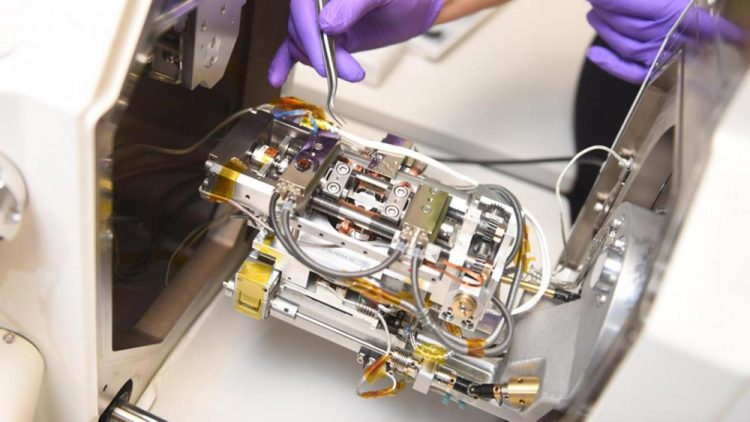New technique allows real-time microscopy at high heat and loading

This photo offers a look inside the in situ scanning electron microscopy (SEM) heating and loading device. The instrument can capture SEM images at temperatures as high as 1,000 degrees Celsius (C), and at stresses as high as two gigapascal -- which is equivalent to 290,075 pounds per square inch. Credit: North Carolina State University
“Until now, you could look at a material's structure before exposing it to heat or load, then apply heat and load until it broke, followed by a microstructural observation. That means you'd only know what it looked like before and after loading and heating,” says Afsaneh Rabiei, corresponding author of a paper on the work and a professor of mechanical and aerospace engineering at North Carolina State University.
“Our technique, which is called 'in situ scanning electron microscopy (SEM) heating and loading,' allows us to see the microscopic changes taking place throughout the process. You can see how cracks form and grow, or how microstructure transforms during the failure process. This is extremely valuable for understanding a material's characteristics and its behavior under different conditions of loading and heating.”
Rabiei developed the in situ SEM technique for high temperatures and load (tension) as a means of conducting high throughput assessments of the behavior of advanced materials. The goal was to be able to predict how a material responds under a variety of heating and loading conditions. The project was supported by the Department of Energy. The instrument can capture SEM images at temperatures as high as 1,000 degrees Celsius (C), and at stresses as high as two gigapascal – which is equivalent to 290,075 pounds per square inch.
For their recent demonstration of the technique's potential, researchers conducted “creep-fatigue” testing on a stainless steel alloy called alloy 709, which is being considered for use in nuclear reactors.
“Creep-fatigue testing involves exposing materials to high heat and repeated, extended loads, which helps us understand how structures will perform when placed under loads in extreme environments,” Rabiei says. “That is clearly important for applications such as nuclear reactors, which are designed to operate for decades.”
To that end, Rabiei and her collaborators tested samples of alloy 709 at temperatures of 750 degrees C, which experienced repeated load cycles ranging from holding the load for one second to holding the load for one hour repeatedly until they failed. In one iteration, where the sample was repeatedly exposed to a load for one hour, with seven-second intervals between loads, the experiment lasted for more than 600 hours. And the in situ SEM captured it all.
“In situ SEM allowed us to track the microscopic development of cracks in the material and the evolution of the microstructure during the creep-fatigue testing,” Rabiei says. “We were then able to use these data to model what alloy 709's behavior would be over years of use in a nuclear reactor. And alloy 709 outperformed 316 stainless steel, which is what's currently used in many reactors.
“That's good news, but what is most exciting here is the methodology we used. For example, our in situ SEM technique allowed us to witness the role that micro-structural details called twin boundaries play in controlling crack growth in alloy 709. Our observations showed that when a crack reaches such twin boundaries in alloy 709, it redirects itself and takes a detour. This detouring effect delays crack growth, improving the material's strength. Without our in situ SEM heating and loading technology, such observations could not be possible. Moreover, using this technique, we only need small specimens and can generate data that normally take years to generate. As such we are saving both time and the amount of material used to evaluate the material's properties and analyze its failure process.
“The ability to capture insights like these is a significant advance for research into any number of new, high-performance materials, particularly those that are designed to perform in extreme environments,” Rabiei says.
The paper, “Performance of alloy 709 under creep-fatigue at various dwell times,” is published in the journal Materials Science and Engineering: A. First author of the paper is Amrita Lall, a Ph.D. student at NC State. The paper was co-authored by Siddhartha Sarkar, a Ph.D. student at NC State; and by Rengen Ding and Paul Bowen of the University of Birmingham.
The work was done with support from the U.S. Department of Energy's Nuclear Energy University Program under award number 2015-1877/DE-NE0008451; and from the Research Councils UK (now UK Research and Innovation) under award number EP/N016351/1.
Media Contact
All latest news from the category: Power and Electrical Engineering
This topic covers issues related to energy generation, conversion, transportation and consumption and how the industry is addressing the challenge of energy efficiency in general.
innovations-report provides in-depth and informative reports and articles on subjects ranging from wind energy, fuel cell technology, solar energy, geothermal energy, petroleum, gas, nuclear engineering, alternative energy and energy efficiency to fusion, hydrogen and superconductor technologies.
Newest articles

NASA: Mystery of life’s handedness deepens
The mystery of why life uses molecules with specific orientations has deepened with a NASA-funded discovery that RNA — a key molecule thought to have potentially held the instructions for…

What are the effects of historic lithium mining on water quality?
Study reveals low levels of common contaminants but high levels of other elements in waters associated with an abandoned lithium mine. Lithium ore and mining waste from a historic lithium…

Quantum-inspired design boosts efficiency of heat-to-electricity conversion
Rice engineers take unconventional route to improving thermophotovoltaic systems. Researchers at Rice University have found a new way to improve a key element of thermophotovoltaic (TPV) systems, which convert heat…



